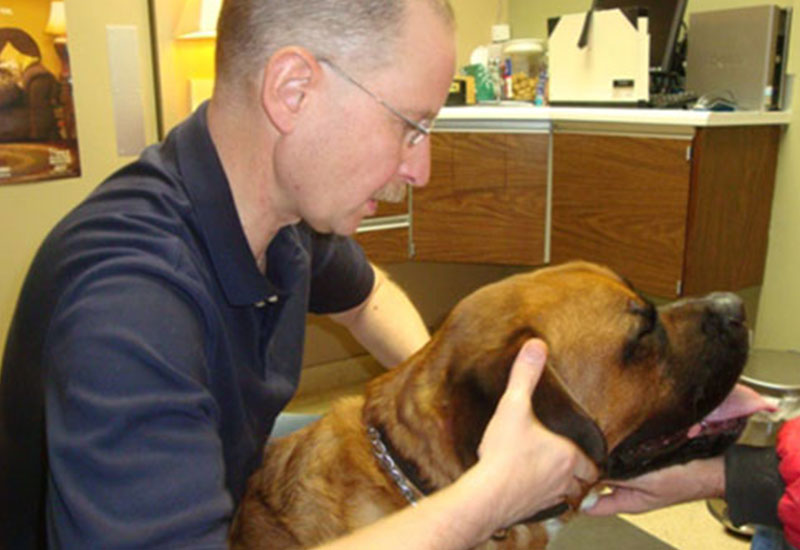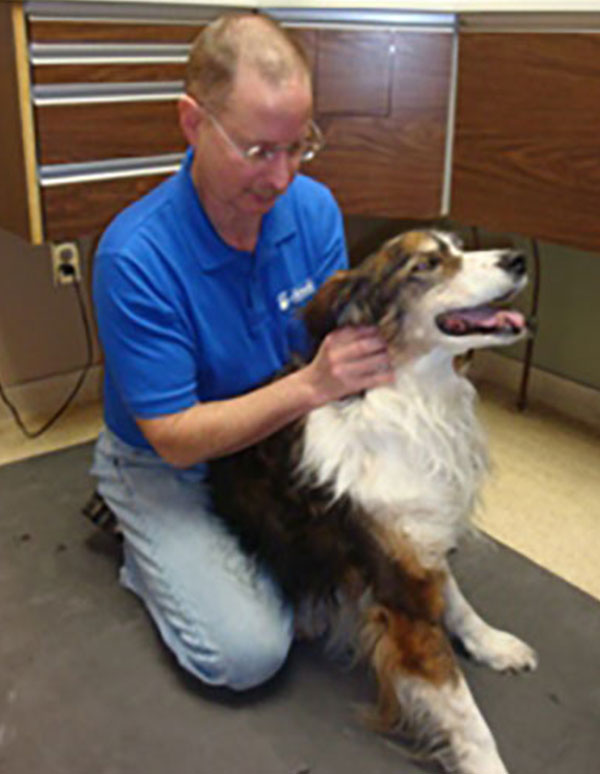Exercise Enduced Collapse In Retreivers
Canine Corner
RETRIEVERS & CHIROPRACTIC, CAN AN ANIMAL CHIROPRACTOR HELP YOUR HUNTING COMPANION?


THE TALEBONE Edition 1
Dr. Mark LaVallie, DC, CVSMT
How Do I Know If My Retriever Needs Chiropractic?
This is by far the most frequently asked question that I get from pet owners. They go on to say, “They cannot tell you. Can they?” The fact is that your animals do tell you when they need help! You just need to know what to look for. Following are three signs that your pet may benefit from a visit to the animal chiropractor.
Incomplete Stretches and Shakes
We have all observed how cats stand and stretch. It’s the first thing they do in the morning. Absence of this full, high-arching stretch is one of the first indications of a spinal or joint problem. The “shake” that dogs and some cats exhibit is frequently observed but not consciously appreciated by owners. The shake that starts at the head and progresses without interruption through the lumbar and the tail is a healthy shake. Dogs that stop a shake somewhere along the spine may be self-splinting a spinal or joint problem. The body’s protective reaction is to splint the area through muscle spasm, so as to prevent further injury.
Swelling, Heat and Muscle Spasm
Through observation, touch, and massage, we can sometimes detect early signs of a treatable problem. When joints are damaged or injured, inflammation and swelling ensues. Significant swelling can often be seen and felt in the extremities, less often in the spine. A more common sign of inflammation in the spinal region is felt as heat or warmth in the tissues overlying the area. The easiest way to feel the heat is to take the back of your fingers and run them slowing down your pet’s spine, noting any significant differences in temperature. To heighten your sense of touch, close your eyes as you run your hand down the spine. Injured joints in the extremities also exhibit warmth when inflamed. Through touch and massage, you can also feel muscle spasms, or “hypertonic muscles.” Muscle spasms are a sign of the splinting action mentioned previously.
Altered Joint Position Sense
With dogs there is a simple and very useful test that provides early clues to nervous system dysfunction. With your dog standing, flip over one paw so it is “knuckled over.” Repeat with the other paws. A normal reaction in a dog with a healthy nervous system is to immediately “flip” the foot back over to its normal position. If your animal takes longer than two seconds to flip its paw back, its “proprioception” or joint position sense, is compromised. Joint position sense is the brain’s ability to know where the limbs are at all times. When a dog has spinal problems, this sensation is the first to go. Your doctor will typically refer to this sensation as “C.P.” Ideally, you should test your pet’s C.P. at least once per month after the age of two.
It’s extremely important to understand that all of the above signs typically go unnoticed by most owners. But these signs precede more severe signs and symptoms of pain and weakness. By the time I first see many animals, their condition has already progressed to weakness, paralysis of a limb or multiple limbs, gait abnormalities, severe pain, and often loss of bowel and bladder control. While a vast majority of these animals respond effectively to chiropractic and veterinary intervention, the earlier the treatment begins, the better the prognosis.
In a perfect world, our goal is to prevent these problems from occurring in the first place. Prevention is a primary goal of many pet owners that have working or performance dogs, show dogs, or have breeds with a hereditary predilection to various maladies. Dachshunds, for instance, have a very high predisposition to thoraco-lumbar disc herniations. German shepherds are prone to hip dysplasia and “degenerative myelopathy.” Small breeds are often susceptible to “luxating patellas.” Labrador retrievers, due to the way they grasp a fetched object, are prone to upper cervical and jaw problems. With any breed, prevention and early detection is the key. According to the American Veterinary Chiropractic Association, chiropractic may be appropriate for:
- Neck, back, leg, and tail pain
- Muscle problems, nerve issues
- Disc problems, joint problems
- Limping and gait abnormalities
- Slip & fall injuries
- Jaw problems, difficult chewing
- Bowel, bladder & digestion
- Post-surgical care and rehab
- Event or sports injuries
- Seizures
- Joint and spinal health
Canine Corner

Chiropractic care does not attempt to replace traditional veterinary care. Animal chiropractors work with your veterinarian to ensure your pet has the most complete care. As a final note, we all realize that animals age at a much faster rate than we do. Therefore, prevention and early recognition of problems is imperative. Chiropractic is a very useful adjunct to traditional veterinary care to maximize your pets “golden years.”
The next issue of The Talebone will answer frequently asked questions regarding animal chiropractic. In future editions, we will discuss specific conditions, prevention, treatment, stretching, and exercise programs, and other topics. Until next time, wishing you and your four-legged friend the best of health.
Dr. Mark “Bones” LaVallie, DC, CVSMT (651) 332-1633
Additional Tips From The Pro’s Articles
- Decoying And Calling: The Hard Facts!
- Decoying Canada Geese – Decoying Canada Geese
- Retrievers & Chiropractic – Can An Animal Chiropractor Help?
- Retriever Performance Events And Why You Should Care
- The Scent Control Debate
- Ten Tips For A More Successful Pheasant Hunt
- Wanton Waste Laws – What Do They Mean & Why Do They Exist?
- How To Get Started Bow Hunting
- The Perfect Deer Rifle
- Exercise Induced Collapse (EIC) In Retrievers – Hunters Beware!
- A Guide To Tipping Your Guide
- Are Canada Geese Actually Getting Smarter Each Fall?
- Top 5 Criteria To Look For in A Fishing Report
- How High Is Too High?
- Turkey Hunting Tips And Tactics
- Realistic Expectations For A Quality Guided Spring Snow Goose Hunt
- Conditioning Your Retriever For The Upcoming Season
